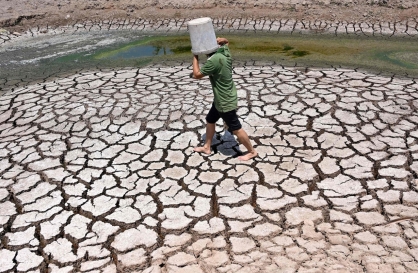The magnitude 9.0 earthquake in Japan has thrown neighboring Koreans a question: How safe are we?
Experts here say Korea is unlikely to suffer such a massive earthquake but caution that the country should be fully alert for all possibilities.
The Ministry of Education, Science and Technology said the chances of a massive earthquake and tsunami affecting Korea are quite slim since the Japanese archipelago blocks risks to the Korean Peninsula.
“The source of the Japanese earthquake was 243 miles northeast of Tokyo, quite far from Korea. The earthquake is unlikely to affect Korea apart from a few possible tremors,” the Korean Meteorological Administration said Saturday. “It could have been a huge blow to Korea had it started at the seas between Korean and Japan. We aren’t seeing any visible damage so far,” the agency added.
Still, Korea isn’t all safe from earthquakes and other natural disasters. According to the Korea Meteorological Administration, there were 42 earthquakes reported last year, a huge jump from the annual average of 16 between 1978 and 1996.
Most of them were minor, which people couldn’t feel. Five of them, however, marked over 3.0 in magnitude, perceptible to people.
This year, there have already been seven reported cases, of which three took place in the seas off Jeju. On Sunday morning, a submarine earthquake was reported near Incheon but no damage has been reported so far.
Should a powerful earthquake hit the peninsula, the damage could be huge. The National Emergency Management Agency on Saturday stated that should an earthquake with magnitude of 6.5 hit Seoul, the death toll could reach 7,700 with 107,500 casualties and an extra 104,000 losing their homes. If the magnitude rises to 7.0, 50,000 people could die and another 620,000 could be severely injured, it said.
Rep. Park Young-ah of the Grand National Party on Sunday revealed that only 18.4 percent of buildings and installations nationwide were earthquake-resistant, leaving the rest vulnerable to a natural disaster.
Based on a separate report from the emergency management agency, Park said that out of 1.7 million buildings mandated to be designed earthquake-resistant, 879,000, or 81.6 percent, did not meet the government rules. Currently, all buildings exceeding 1,000 square-meters, or over three stories in height, should be earthquake-proof. The regulations were introduced after a 8.0 magnitude earthquake struck Sichuan in China in 2008, killing 70,000 people.
“Especially schools, which are used as shelters in emergencies, aren’t ready,” Park said. “As we see in Japan’s case, earthquakes come without notice. The only way to minimize the damage is to prepare against it ahead,” she said, calling for the government to prioritize the construction of earthquake-resistant buildings.
By Bae Ji-sook (baejisook@heraldcorp.com)
Experts here say Korea is unlikely to suffer such a massive earthquake but caution that the country should be fully alert for all possibilities.
The Ministry of Education, Science and Technology said the chances of a massive earthquake and tsunami affecting Korea are quite slim since the Japanese archipelago blocks risks to the Korean Peninsula.
“The source of the Japanese earthquake was 243 miles northeast of Tokyo, quite far from Korea. The earthquake is unlikely to affect Korea apart from a few possible tremors,” the Korean Meteorological Administration said Saturday. “It could have been a huge blow to Korea had it started at the seas between Korean and Japan. We aren’t seeing any visible damage so far,” the agency added.
Still, Korea isn’t all safe from earthquakes and other natural disasters. According to the Korea Meteorological Administration, there were 42 earthquakes reported last year, a huge jump from the annual average of 16 between 1978 and 1996.
Most of them were minor, which people couldn’t feel. Five of them, however, marked over 3.0 in magnitude, perceptible to people.
This year, there have already been seven reported cases, of which three took place in the seas off Jeju. On Sunday morning, a submarine earthquake was reported near Incheon but no damage has been reported so far.
Should a powerful earthquake hit the peninsula, the damage could be huge. The National Emergency Management Agency on Saturday stated that should an earthquake with magnitude of 6.5 hit Seoul, the death toll could reach 7,700 with 107,500 casualties and an extra 104,000 losing their homes. If the magnitude rises to 7.0, 50,000 people could die and another 620,000 could be severely injured, it said.
Rep. Park Young-ah of the Grand National Party on Sunday revealed that only 18.4 percent of buildings and installations nationwide were earthquake-resistant, leaving the rest vulnerable to a natural disaster.
Based on a separate report from the emergency management agency, Park said that out of 1.7 million buildings mandated to be designed earthquake-resistant, 879,000, or 81.6 percent, did not meet the government rules. Currently, all buildings exceeding 1,000 square-meters, or over three stories in height, should be earthquake-proof. The regulations were introduced after a 8.0 magnitude earthquake struck Sichuan in China in 2008, killing 70,000 people.
“Especially schools, which are used as shelters in emergencies, aren’t ready,” Park said. “As we see in Japan’s case, earthquakes come without notice. The only way to minimize the damage is to prepare against it ahead,” she said, calling for the government to prioritize the construction of earthquake-resistant buildings.
By Bae Ji-sook (baejisook@heraldcorp.com)








![[Graphic News] More Koreans say they plan long-distance trips this year](http://res.heraldm.com/phpwas/restmb_idxmake.php?idx=644&simg=/content/image/2024/04/17/20240417050828_0.gif&u=)
![[KH Explains] Hyundai's full hybrid edge to pay off amid slow transition to pure EVs](http://res.heraldm.com/phpwas/restmb_idxmake.php?idx=644&simg=/content/image/2024/04/18/20240418050645_0.jpg&u=20240419100350)





![[From the Scene] Monks, Buddhists hail return of remains of Buddhas](http://res.heraldm.com/phpwas/restmb_idxmake.php?idx=652&simg=/content/image/2024/04/19/20240419050617_0.jpg&u=20240419175937)

![[KH Explains] Hyundai's full hybrid edge to pay off amid slow transition to pure EVs](http://res.heraldm.com/phpwas/restmb_idxmake.php?idx=652&simg=/content/image/2024/04/18/20240418050645_0.jpg&u=20240419100350)

![[Today’s K-pop] Illit drops debut single remix](http://res.heraldm.com/phpwas/restmb_idxmake.php?idx=642&simg=/content/image/2024/04/19/20240419050612_0.jpg&u=)